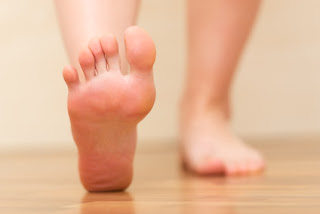- Check your feet daily. Look for any odd spots, cuts, swelling, or bruises, and use a mirror to check the soles and between toes.
- Keep toenails neatly trimmed, and cuticles pushed back. Consider having stubborn corns or callouses removed.
- Wear comfortable, properly-fitting shoes and socks. Discuss with your doctor whether you need special orthotic shoes, or maybe even compression socks to help with circulation.
- Wash your feet daily, and keep them moisturized. Heels are particularly prone to dry, cracked skin.
- Exercise your feet to keep the blood flowing. Wiggle toes and perform ankle rotations throughout the day, especially when seated for long periods of time.
Diabetes and Foot Care
As Diabetes Awareness Month wraps up, we want to address a topic that is critically important for diabetic patients… foot care.
People suffering from diabetes often have to deal with many painful side effects of the disease, with one of the most common being unhealthy feet. Poor circulation and painful skin sores are typical, and if left untreated can lead to loss of feeling and ultimately amputation in some cases.
Oftentimes a doctor treating diabetics also will recommend seeing a foot specialists, such as an orthopedist or podiatrist, for frequent check-ups.
“People suffering from diabetes may think managing diet and glucose levels is enough, but that is not the case,” says Dr. Tim Gueramy. “We see a lot of patients who unfortunately neglect their feet, and amputation is sometimes necessary if the damage is severe.”
Here are tips for healthy feet if you are faced with diabetes:
Contact your physician if you have serious cuts or abrasions on your feet, notice a change in skin color, or experience greater or lesser sensitivity to feeling.
(Courtesy of the American Diabetes Association)
Keep up with Texas Orthopedics news by following us on Facebook and Twitter (@TexasOrthopedic).



